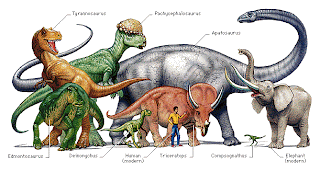
Dinosaurs are a diverse group of reptiles. They were the dominant terrestrial vertebrates for over 160 million years, from the late Triassic period (about 230 million years ago) until the end of the Cretaceous period (about 65 million years ago), when the Cretaceous–Tertiary extinction event caused the extinction of most dinosaur species, except for some birds. The fossil record indicates that birds evolved from theropod dinosaurs during the Jurassic period, and most paleontologists regard them as the only group of dinosaurs to have survived until the present day.[1]
Dinosaurs are a diverse and varied group of animals; birds, at over 9,000 species, are the most diverse group of vertebrate besides perciform fish.[2] Paleontologists have identified over 500 distinct genera[3] and more than 1,000 different species of non-avian dinosaurs.[4] Dinosaurs are represented on every continent by both extant species and fossil remains.[5] Some dinosaurs are or were herbivorous, others carnivorous. Some have been bipedal, others quadrupedal, and others have been able to shift between these body postures. Many non-avian species developed elaborate skeletal modifications such as bony armor, horns or crests. Avian dinosaurs have been the planet's dominant flying vertebrate since the extinction of the pterosaurs. Although generally known for the large size of some species, most dinosaurs were human-sized or even smaller. Most groups of dinosaurs are known to have built nests and laid eggs.
The term "dinosaur" was coined in 1842 by the English paleontologist Richard Owen, and derives from Greek δεινός (deinos) "terrible, powerful, wondrous" + σαῦρος (sauros) "lizard". Through the first half of the twentieth century, most of the scientific community mistakenly believed dinosaurs to have been sluggish, unintelligent cold-blooded animals. Most research conducted since the 1970s, however, has indicated that dinosaurs were active animals with elevated metabolisms and numerous adaptations for social interaction.
Since the first dinosaur fossils were recognized in the early nineteenth century, mounted dinosaur skeletons have been major attractions at museums around the world, and dinosaurs have become a part of world culture. They have been featured in best-selling books and films such as Jurassic Park, and new discoveries are regularly covered by the media. The outdated image of dinosaurs as maladapted extinct monsters has led to the word "dinosaur" entering the vernacular to describe anything that is impractically large, slow-moving, obsolete, or bound for extinction.[6]The taxon Dinosauria was formally named in 1842 by Sir Richard Owen, who used it to refer to the "distinct tribe or sub-order of Saurian Reptiles" that were then being recognized in England and around the world.[7] The term is derived from the Greek words δεινός (deinos meaning "terrible", "powerful", or "wondrous") and σαῦρος (sauros meaning "lizard" or "reptile").[8] Though the taxonomic name has often been interpreted as a reference to dinosaurs' teeth, claws, and other fearsome characteristics, Owen intended it merely to evoke their size and majesty.[9] In colloquial English "dinosaur" is sometimes used to describe an obsolete or unsuccessful thing or person,[10] despite the dinosaurs' 160 million year reign and the global abundance and diversity of their avian descendants: modern-day birds.
Dinosaur
7:14 AM |
Subscribe to:
Post Comments (Atom)






0 comments:
Post a Comment